What follows is drawn from modern sources; it contains (mostly modern) images and information about a number of the places described by Johann Georg Keyssler in his travel book Neueste Reisen durch Deutschland, Böhmen, Ungarn, die Schweiz, Italien und Lothringen, with which Leopold Mozart was very familiar. Extracts from the contemporary English translation of the book form the basis of the Event entity 1770 A Day Trip Around the Bay of Naples. There are links between the places included below and their corresponding entries in the Day Trip event. It is anticipated that most readers will base their reading on the Day Trip event, and follow the links to the material below as interest dictates. At the end of each description below there is a link back to the corresponding location in the Day Trip narrative. However, for the benefit of readers who wish to use this material as a free-standing section, it begins with an index to the locations described.
Note: The locations appear in this entity in alphabetic sequence, whereas in the Day Trip event their sequence follows Keyssler's narrative.
Agripinna's Sepulchre
Arco Felice
Astroni Crater
Baia / Baiae
Campi Flegrei (Phlegrean Fields)
Cuma (Cumae)
Cumaean Sibyl
Dead Sea / Mare Morto
Grotta del Cane
Lago d'Averno
Lago di Agnano
Lago di Lucrino
Miseno (Misenum)
Monte Gauro / Monte Barbaro
Monte Nuovo
Piscina Mirabilis
Posillipo Tunnel / Roman Seiano tunnel
Pozzuoli
Pozzuoli - Cathedral
Pozzuoli - Old harbour
Solfatara
Temple of Diana
Temple of Mercury
Temple of Venus
Virgil's Tomb
Agripinna's Sepulchre
Agripinna's Sepulchre
The truth about Agrippina, her death, and her remains are as difficult to find as the location itself. Signs for her tomb appear and then vanish throughout the twisting Campi Flegrei roads, but plug Piazza Guglielmo Marconi into a GPS and you’ll see the Via Agrippina sign that leads down to a port. Park your car and make your way along crumbling buildings and a walkway by the sea. Another sign marks the tomb, whose bricks today are overgrown with weeds. A fence bars visitors as though making clear that the owners haven’t paid their rent in years.
It’s unknown if the people who called these stones the Tomb of Agrippina meant Agrippina the Elder or Agrippina the Younger — the story of each woman full of intrigue.
Agrippina the Elder was the granddaughter of Augustus, mother of Caligula, and grandmother of Nero.
Agrippina the Younger was the daughter of Agrippina the Elder and also the mother of Emperor Nero.
Source: Napoli Unplugged https://www.napoliunplugged.com/the-tomb-of-agrippina.html
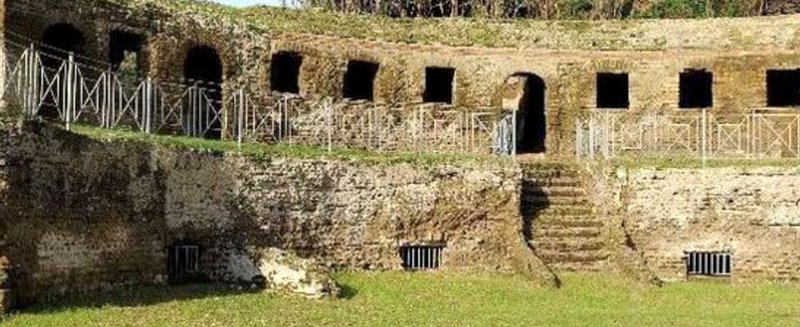
Agripinna’s tomb??
http://1.citynews-napolitoday.stgy.ovh/~media/original-hi/55552018124980/schermata-2018-06-15-alle-23-15-51-2.jpg
Bay of Naples Day Trip: Agripinna's Sepulchre
Arco Felice
Arco Felice
There really is a part of Naples called Arco Felice (Happy Arch!). It's actually part of the town of Pozzuoli and is adjacent to Bacoli along the beach almost to Baia as you approach the western end of the Gulf of Naples along the sea-side. It was, in fact, a port in ancient times, serving Cuma. Currently, the population is about 10,000. Arco Felice is smack in the middle of all the Flegrean lakes of mythology: Fusaro, Averno and Lucrino.
The arch spans an artificial gap in Mt. Grillo. That gap was one of those works planned by emperor Domitian in 95 AD as part of general construction of the Via Domiziana road to connect Rome and Naples. Road construction in ancient Rome (and, indeed, in modern Italy) worked on the principle of "Why go around it when you can go through it? Thus, they banged through part of the mountain and built two sturdy cement sustaining walls in order to support the steep sides of the gap. To connect one side with the other, they built a wall lined with brick, with cement supports and with an internal passage and arched vault. The imposing structure is 20 meters high and 6 meters wide.
Source: http://www.naplesldm.com/arcofelice.php
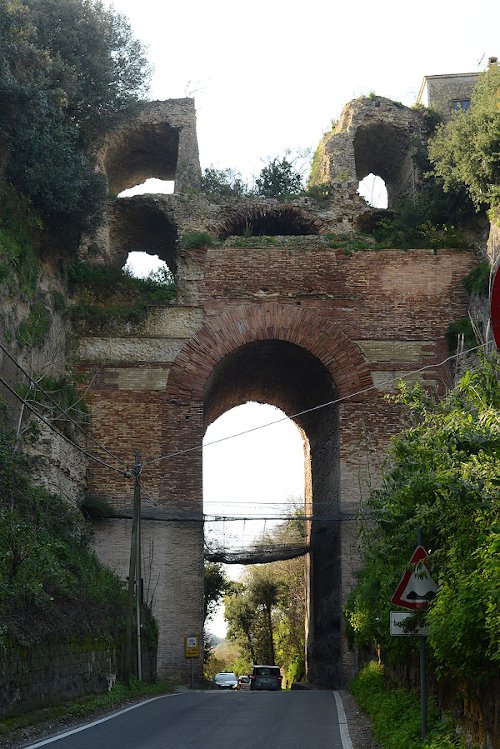
Arco Felice (Ruthven)
https://commons.wikimedia.org/w/index.php?curid=67719273
Bay of Naples Day Trip: Arco Felice
Astroni Crater
Astroni Crater
Cratere degli Astroni is an extinct volcano belonging to the greater Agnano crater in the Phlegrean field caldera. At 3600 years old it is the youngest crater of the Phlegrean fields.
Most of the crater is covered in forest. At the bottom of the crater are three lakes (Lago Grande, Cofaniello Piccolo e Cofaniello Grande) and a number of small hills (Colle dell'Imperatore and Colle della Rotondella) formed during a series of volcanic eruptions.
Visitors to the Cratere degli Astroni nature reserve may choose among a wide range of theme based trails: from the historical to geological, from the botanical to the zoological, every path has its own peculiarity but all are closely related.
Source: https://www.wwf.it/oasi/campania/cratere_degli_astroni/cratere_degli_astroni__english_version_.cfm
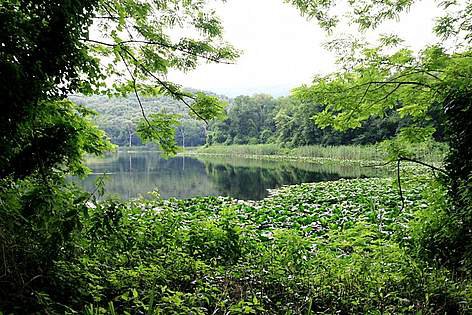
Astroni Crater Nature Reserve
Source: https://www.wwf.it/oasi/campania/cratere_degli_astroni/cratere_degli_astroni__english_version_.cfm
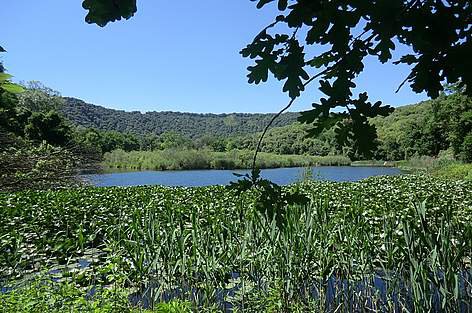
Astroni Crater Nature Reserve
Source: https://colandwiki.hfwu.de/index.php?title=File:3_astroni_crater_state_nature_reserve_heritage.jpg
Bay of Naples Day Trip: Astruni
Baia / Baiae
Baia / Baiae
In its heyday, the classical Roman city of Baia was the hedonist Las Vegas of the time, but now its remains are partying beneath the waves.
A prominent resort city for centuries, Baia catered to the recreational whims of the rich and powerful among the Roman elite. The city, which was located over natural volcanic vents, was famous for its healing medicinal hot springs which occurred all around the city and were quite easy to build spas over. Some of antiquity’s most powerful figures such as Nero, Cicero, and Caesar were known to have visited the city and a number of them actually built permanent vacation villas there.
Unfortunately, the good times were not to last and the city was sacked by a Muslim army in the 8th century. By 1500, the remains of the formerly luxurious town were abandoned. After the city remains were emptied, the water level slowly rose due to the same volcanic vents that were once a draw to the area, and most of the ancient ruins were drowned under the shallow waters of the bay.
Today the ancient remains of Baia can be visited in one of the world’s few underwater archeological parks. Visitors can view the crumbled structures and amazingly preserved statuary of the city through glass-bottomed boats, snorkeling, or even scuba dives which allow people to actually swim amongst the copious ruins. While the city is no longer a resort, its waters still hold wonders.
Source: Atlas Obscura https://www.atlasobscura.com/places/the-sunken-city-of-baia-baia-italy
The lowering of the ground below sea level, due to bradyseism, seems to have occurred in two phases: between the third and fifth centuries, still in the late Imperial era, followed by a more substantial submersion a century later. The lower part of Baiae was largely submerged by the sea by the 8th century.
Source: Wikipedia https://en.wikipedia.org/wiki/Baiae
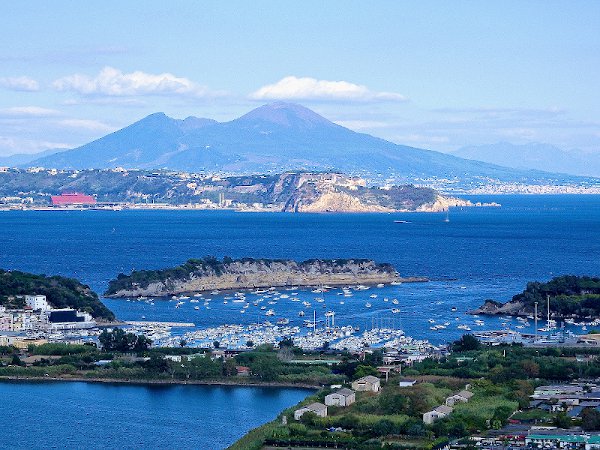
Baia - landscape
https://timelessitaly.files.wordpress.com/2014/03/p92205821.jpg
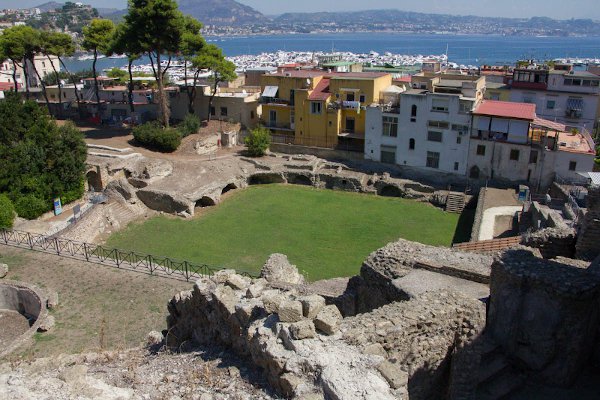
Baia - Bath complex
https://www.blasdale.com/blog/wp-content/gallery/2013-italy-baia-bathing-complex/img_3434.jpg
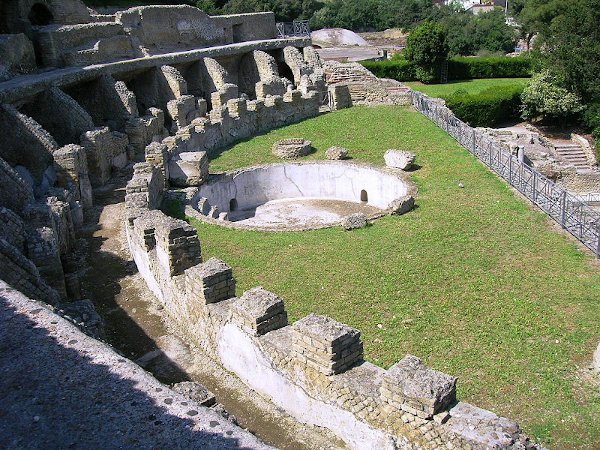
Settore di Sosandra (Sosandra Sector - where baths and accommodation were (Mentnafunangann)
https://commons.wikimedia.org/w/index.php?curid=32519416
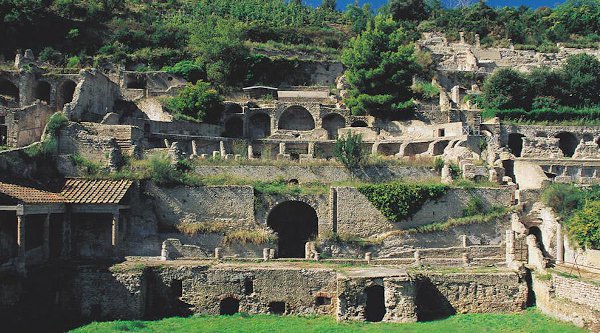
Baia - Baths
https://visit.marketing-italia.eu/uploads/visitnaples/uploads_articoli/paragrafo/2018030113Terme%20di%20Baia.jpg
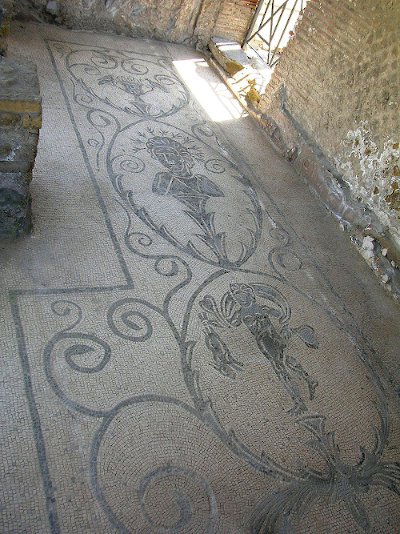
Mosaic in the Baths of Venus (Mentnafunangann)
https://commons.wikimedia.org/w/index.php?curid=32519758
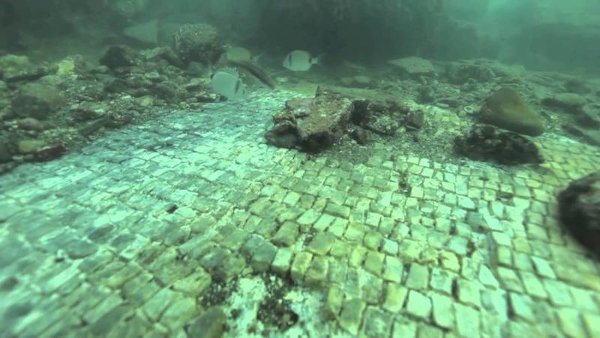
Baia - Underwater city
http://www.lateet.com/wp-content/uploads/2015/10/Baia-The-Roman-City-Beneath-The-Waves.jpg
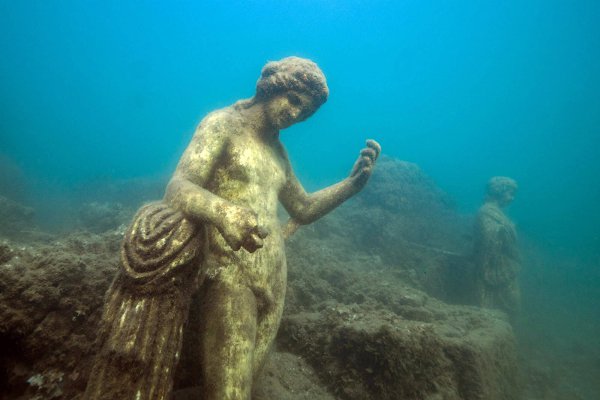
Baia - Underwater city: statues
https://divebuddies4life.com/app/uploads/Twitter-Ancient-Roman-Statutes-Underwater-at-the-Baiae-Scuba-Diving-Site-in-Naples-Italy.jpg
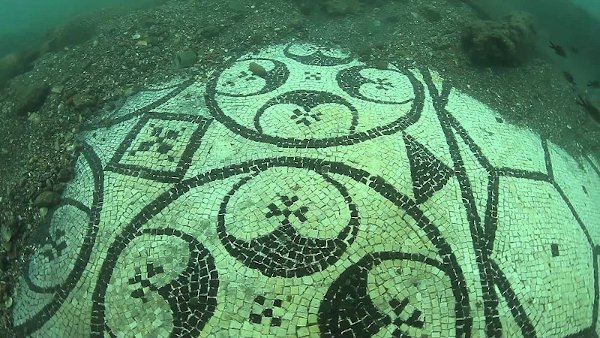
Baia - Underwater city: mosaics
https://lh3.googleusercontent.com/-f_fFWT8wJ2Y/WAju3InP0cI/AAAAAAABQSo/9d3bK0fFIrc/baia-underwater-park-32.jpg?imgmax=1600
Bay of Naples Day Trip: Baia / Baiae
Campi Flegrei (Phlegrean Fields)
Campi Flegrei (Phlegrean Fields)
The Phlegraean Fields is a large volcanic area situated to the west of Naples, Italy. It was declared a regional park in 2003. The area of the caldera consists of 24 craters and volcanic edifices; most of them lie under water. Hydrothermal activity can be observed at Lucrino, Agnano and the town of Pozzuoli. There are also effusive gaseous manifestations in the Solfatara crater, the mythological home of the Roman god of fire, Vulcan. This area is monitored by the Vesuvius Observatory.
Source: Wikipedia https://en.wikipedia.org/wiki/Phlegraean_Fields
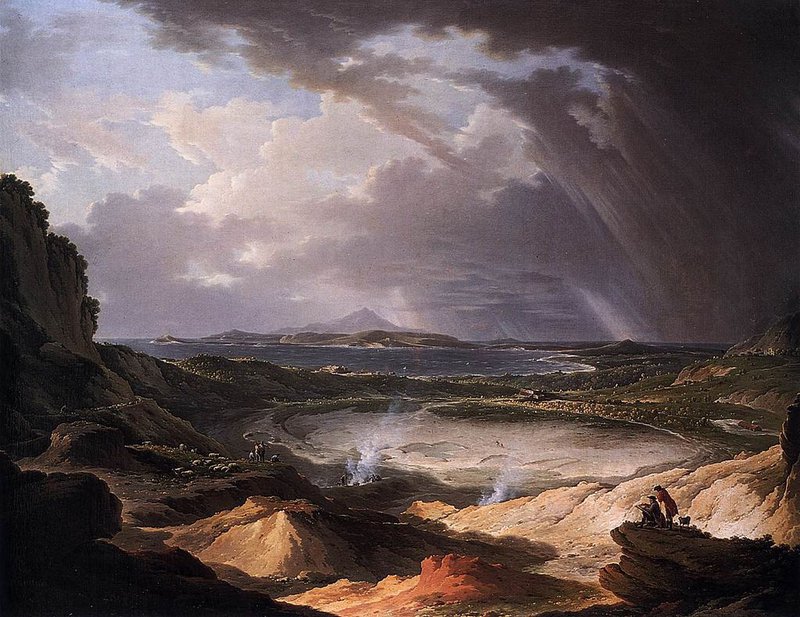
Michael Wutky: Solfatara and Campi Flegrei 1770s
Source: By Michael Wutky - Web Gallery of Art, Public Domain, https://commons.wikimedia.org/w/index.php?curid=42244460
Michael Wutky (1739, Krems an der Donau - 28 September 1822/23, Vienna) was an Austrian landscape painter in the Rococo style who specialized in Italian scenes... He is best known for the paintings he produced during a stay in Naples. Mount Vesuvius was especially active at that time, and he took the opportunity to capture close-up scenes of the eruptions and lava flows. Accompanied by the English diplomat and volcanologist, Sir William Hamilton, he even made risky trips close to the volcano's crater. Until the advent of photography, his paintings were considered to be the most scientifically accurate representations of a volcanic eruption.
Source: Wikipedia https://en.wikipedia.org/wiki/Michael_Wutky
Bay of Naples Day Trip: Monte Secco/Solfatara
Cuma (Cumae)
Cuma (Cumae)
Cumae (Ancient Greek: Κύμη, romanized: (Kumē) or Κύμαι (Kumai) or Κύμα (Kuma); Italian: Cuma) was the first ancient Greek colony on the mainland of Italy, founded by settlers from Euboea in the 8th century BC and soon becoming one of the strongest colonies. It later became a rich Roman city, the remains of which lie near the modern village of Cuma.
The archaeological museum of the Campi Flegrei in the Aragonese castle contains many finds from Cumae.
Source: https://en.wikipedia.org/wiki/Cumae
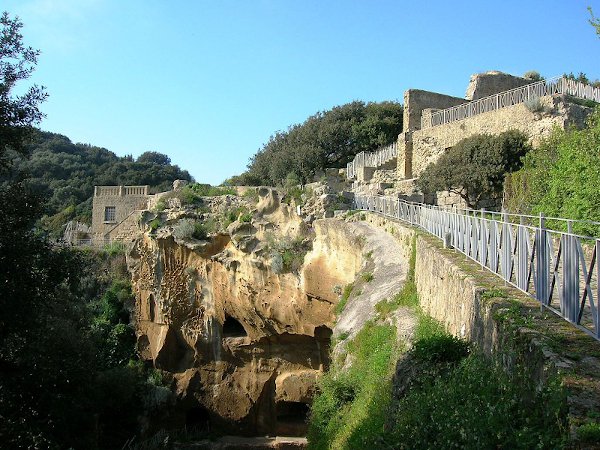
Cuma: Acropolis (Mentnafunangann)
https://commons.wikimedia.org/w/index.php?curid=14878198
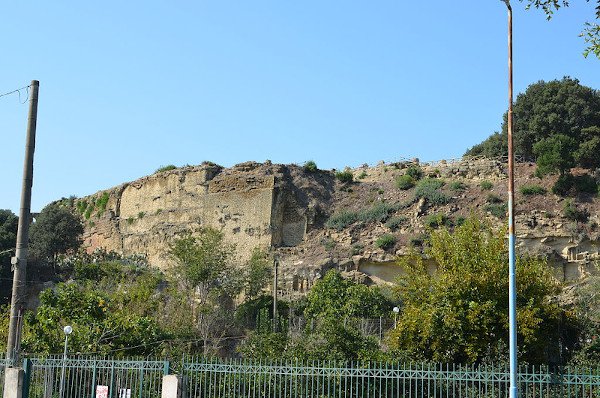
Cuma: Acropolis Wall (Alexander Van Loon)
https://commons.wikimedia.org/w/index.php?curid=30166493
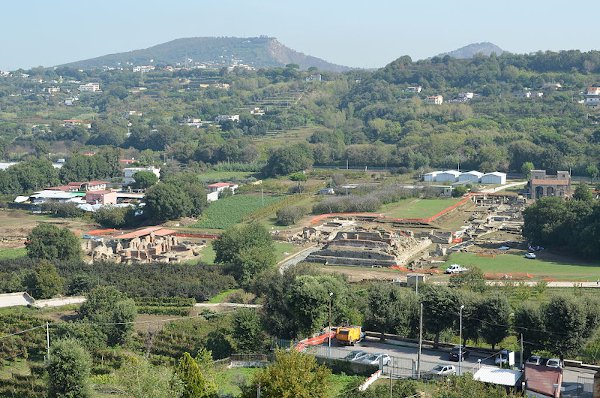
Cuma: lower city from acropolis (Alexander Van Loon)
https://commons.wikimedia.org/w/index.php?curid=30166495
Bay of Naples Day Trip: Cuma (Cumae)
Cumaean Sibyl
Cumaean Sibyl
The Cumaean Sibyl was the priestess presiding over the Apollonian oracle at Cumae, a Greek colony located near Naples, Italy. The word sibyl comes (via Latin) from the ancient Greek word sibylla, meaning prophetess. There were many sibyls in different locations throughout the ancient world. Because of the importance of the Cumaean Sibyl in the legends of early Rome as codified in Virgil's Aeneid VI, and because of her proximity to Rome, the Cumaean Sibyl became the most famous among the Romans.
The Cumaean Sibyl is one of the four sibyls painted by Raphael at Santa Maria della Pace. She was also painted by Andrea del Castagno (Uffizi Gallery), and in the Sistine Chapel Ceiling of Michelangelo her powerful presence overshadows every other sibyl, even her younger and more beautiful sisters, such as the Delphic Sibyl.
Source: https://en.wikipedia.org/wiki/Cumaean_Sibyl
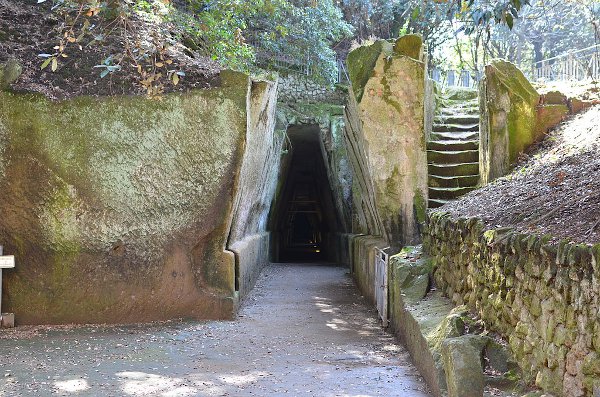
Cumae Sibyl's Cave (Alexander Van Loon)
https://commons.wikimedia.org/w/index.php?curid=30166492
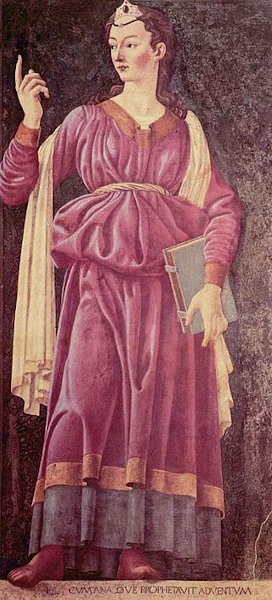
Cumaean Sibyl by Andrea del Castagno, at the Uffizi Gallery
https://commons.wikimedia.org/w/index.php?curid=10537645
Bay of Naples Day Trip: Cumaean Sibyl
Dead Sea / Mare Morto
Dead Sea / Mare Morto
Miseno harbour consisted of the outer basin, or Porto di Miseno, protected by moles, of which remains still exist, and the present Mare Morto, separated from it by a comparatively modern embankment.
Source: https://en.wikisource.org/wiki/1911_Encyclop%C3%A6dia_Britannica/Misenum
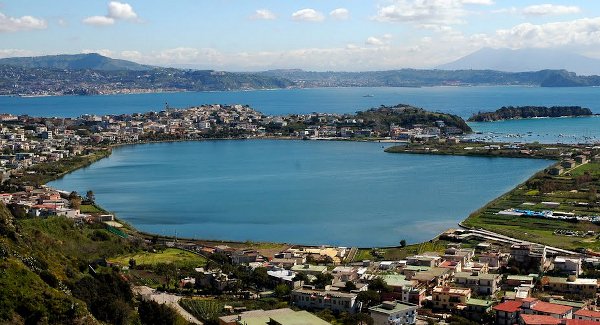
Miseno: Mare Morto (Dead Sea)
https://acquedottihirpinia.files.wordpress.com/2016/03/lago-miseno.png
Bay of Naples Day Trip: Dead Sea
Grotta del Cane
Grotta del Cane
The Cave of Dogs is a small cave on the eastern side of the Phlegraean Fields (Campi Flegrei) near Pozzuoli, Naples. Inside the cave is a fumarole that releases carbon dioxide of volcanic origin. It was a famous, if gruesome, tourist attraction for travellers on the Grand Tour. The CO2 gas, being denser than air, tends to accumulate in the deeper parts of the cave. Local guides, for a fee, would suspend small animals inside it—usually dogs—until they became unconscious. Because humans inhaled air from a higher level they were not affected. The dogs might be revived by submerging them in the cold waters of the nearby Lake Agnano. Tourists who came to see this attraction included Goethe, John Evelyn, Alexandre Dumas père, and Mark Twain. The lake became polluted and it was drained in 1870
Source, including the following two images: Wikipedia https://en.wikipedia.org/wiki/Cave_of_Dogs

Grotta del Cane
By Anonymous, probablement Jules Marie Désandré - L'air et le monde aèrien, an 1865 textbook by Arthur Mangin, p.162,
Public Domain, https://commons.wikimedia.org/w/index.php?curid=43062989
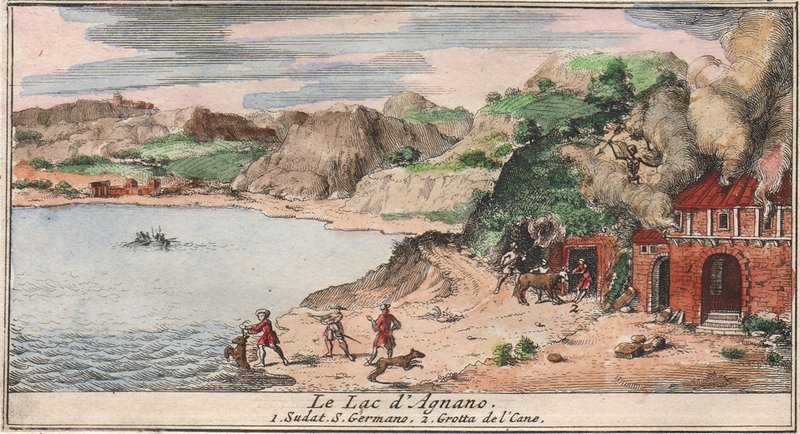
Lago di Agnano and Grotta del Cane
By Sieur de Rogissart - Les délices de l’Italie, Vol. III, Leida, Pierre Vander, 1706,
Public Domain,https://commons.wikimedia.org/w/index.php?curid=59582426
Bay of Naples Day Trip: Grotta del Cane
Lago d'Averno
Lago d'Averno
Lake of Averno - Italian Lago D’averno, Latin Lacus Avernus - is a crater lake in Napoli province, in the Campi Flegrei volcanic region, west of Naples. It is 7 ft (2 m) above sea level, 118 ft deep, and nearly 2 mi (more than 3 km) in circumference, with no natural outlet. Its Greek name, Aornos, was interpreted as meaning “without birds,” giving rise to the legend that no bird could fly across it and live because of its poisonous sulfurous vapours. Surrounded by dense forests in ancient times, it was represented by the poet Virgil as the entrance to Hades.
Source: Britannica.com https://www.britannica.com/place/Lake-of-Averno
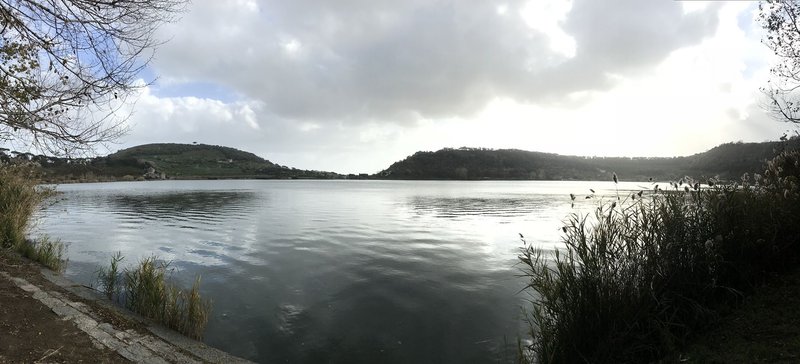
Lake Avernus (Lago di Averno)
https://www.alltrails.com/trail/italy/campania/lake-avernus-lago-di-averno
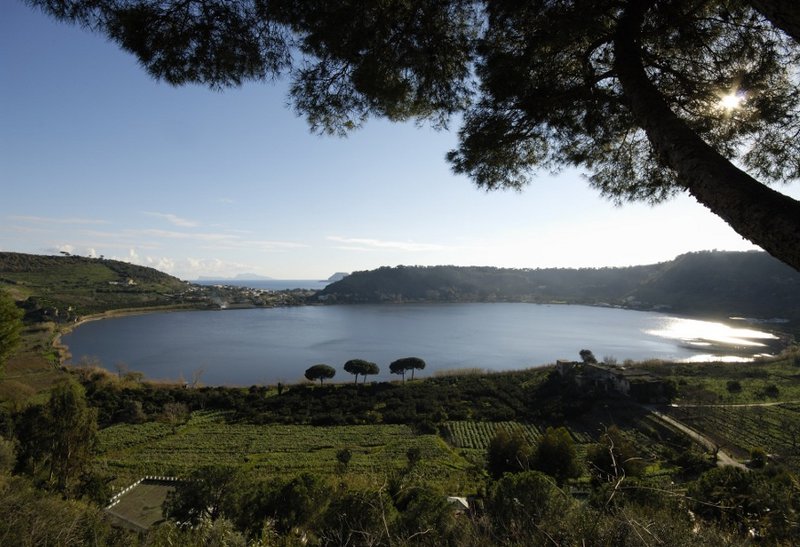
Bay of Naples Day Trip: Lago d'Averno
Lago di Agnano
Lago di Agnano
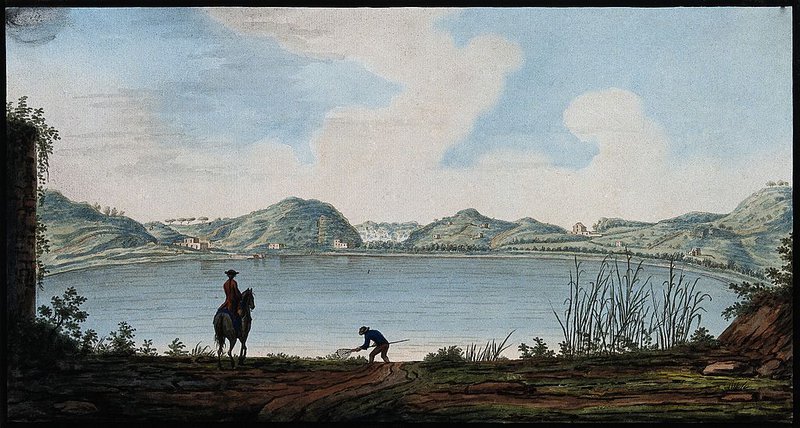
Pietro Fabris, Lago di Agnano
Lago di Agnano or Lake Agnano was a circular lake, some 6½ km in circumference, which occupied the crater of the extinct volcano of Agnano 8 km west of Naples, Italy. It was apparently not formed until the Middle Ages, as it is not mentioned by ancient writers; it was drained in 1870.
On the south bank are the Stufe di San Germano, natural sulphureous vapour baths, and close by is the Grotta del Cane. From the floor of this cave warm carbonic acid gas constantly rises to a height of 18 inches (46 cm): the fumes render a dog insensible in a few seconds. Remains of an extensive Roman building and some statues have been discovered close by.
Source: Wikipedia https://en.wikipedia.org/wiki/Lake_Agnano. "The article incorporates text from a publication now in the public domain: Chisholm, Hugh, ed. (1911). "Agnano, Lago Di". Encyclopædia Britannica. 1 (11th ed.). Cambridge University Press."
Bay of Naples Day Trip: Lago di Agnano
Lago di Lucrino
Lago di Lucrino
The lake was considered an infernal place, due to volcanic phenomena. It was a renowned resort in Roman times and included the villa of Cicero, which later held the remains of emperor Hadrian. Pliny the Elder cites it in Naturalis historia (ix, 25) as the home of a dolphin who had made friends with a child. According to Pliny, when the child fell ill and died, the dolphin died of broken heart also. The tale is considered the first known Urban legend.
Source: Wikipedia https://en.wikipedia.org/wiki/Pozzuoli
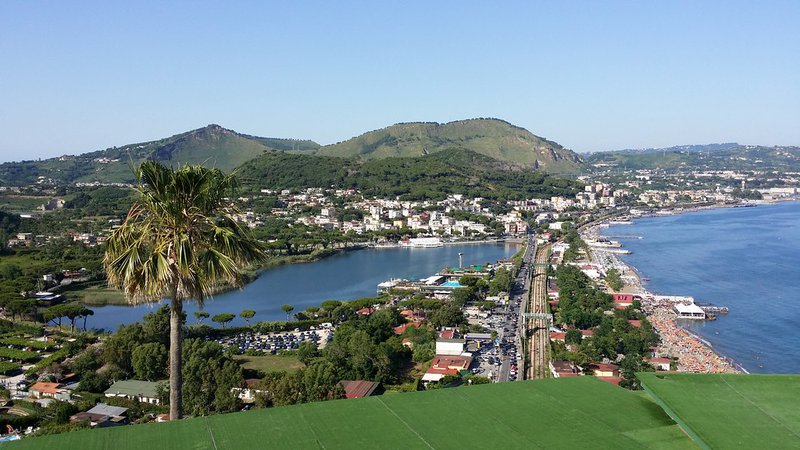
Lago di Lucrino
https://farm4.staticflickr.com/3903/15291338531_b1cdefcd9b_b.jpg
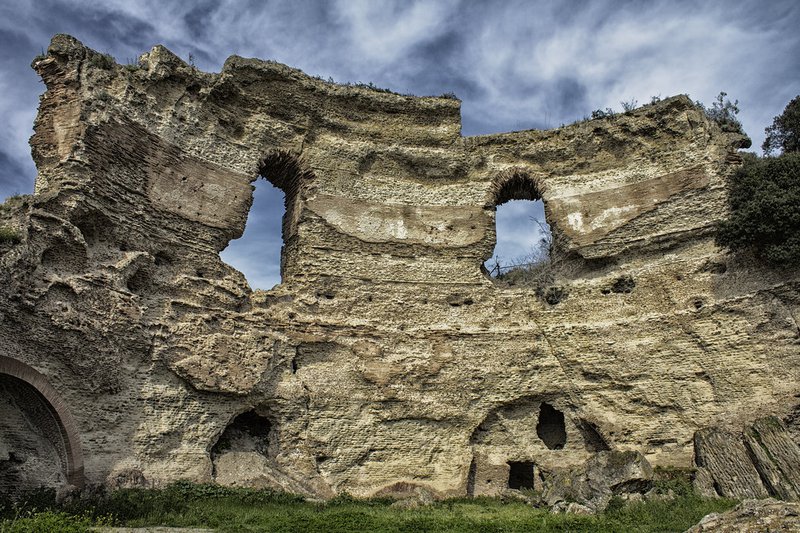
Ruins at Lago di Lucrino
https://farm9.staticflickr.com/8398/8673734917_3e5af34a64_b.jpg
Bay of Naples Day Trip: Lago di Lucrino
Miseno (Misenum)
Miseno (Misenum)
According to mythology, Misenum was named after Misenus, a companion of Hector and trumpeter to Aeneas. Misenus is supposed to have drowned near here after a trumpet competition with the sea-god Triton, as recounted in Virgil's Aeneid.
In 39 BC, Misenum was the site where a short-lived pact was made between Octavian (heir of Julius Caesar, who later became the emperor Augustus), and his rival Sextus Pompeius.
Misenum was first established as a naval base (Portus Julius) during the civil wars in 27 BC by Marcus Agrippa, the right-hand man of the emperor Augustus. It was then developed into the largest Roman port for the Classis Misenensis, the most important fleet.
With its gorgeous natural setting close to the naval base and the nearby important Roman cities of Puteoli and Neapolis, Misenum also became the site of Roman luxury villas, such as the Villa of Lucullus.
Pliny the Elder was the praefect in charge of the naval fleet at Misenum in AD 79, at the time of the eruption of Mount Vesuvius, visible to the south across the Bay of Naples. Seeing the beginnings of the eruption, Pliny left for a closer view and to effect a possible rescue, and was killed during the eruptions. The account of his death is given by his nephew Pliny the Younger, who was also resident in Misenum at the time.
Notable residents
It is said to be the birthplace of Saint Sossius, a deacon who was martyred with Proculus of Pozzuoli. It is also the place of death of Emperor Tiberius. The Roman empress Agrippina the Younger lived in a palace here, once owned by the orator Hortensius (then by the emperors, and some three centuries later by Symmachus) in which she resided in the months before her death.
In fiction
Misenum is one of the main settings in Robert Harris' novel Pompeii, whose protagonist, Attilius, works as the aquarius at the Piscina Mirabilis (the terminal reservoir into which the Aqua Augusta aqueduct emptied).
In the novel Ben-Hur, Misenum is the location of a villa owned by Quintus Arrius later bequeathed to his adopted son Judah Ben-Hur. The Ben-Hur family would later live in Misenum.
Source: Wikipedia https://en.wikipedia.org/wiki/Miseno
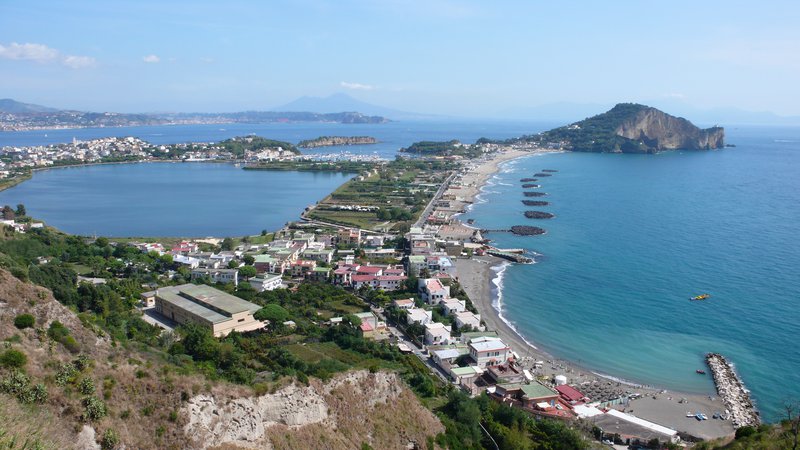
Cape Miseno and Lago Miseno/Mare Morto
https://upload.wikimedia.org/wikipedia/commons/c/cf/MisenoLago1030343TAW.JPG
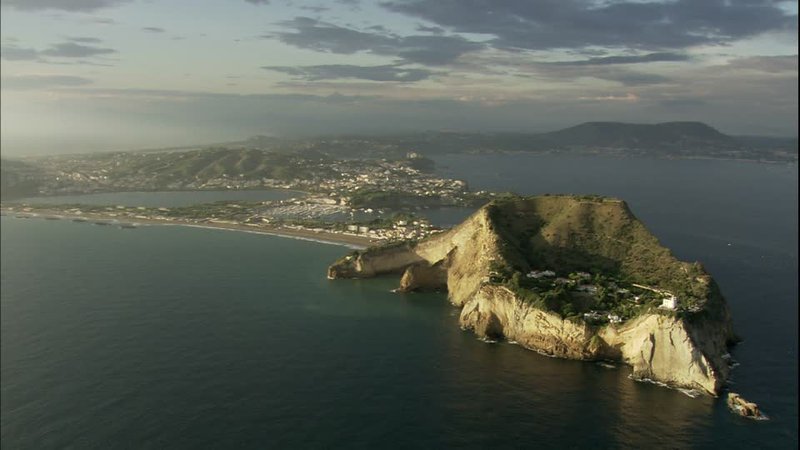
Cape Miseno - Gulf of Pozzuoli
http://footage.framepool.com/shotimg/qf/968246276-cape-miseno-the-gulf-of-pozzuoli-peninsula-cape-landscape.jpg
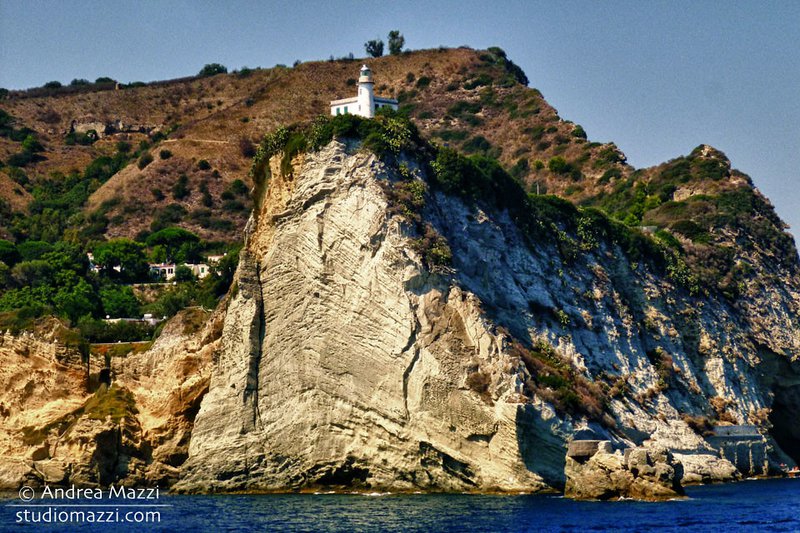
Cape Miseno (Andrea Mazzi)
https://farm9.staticflickr.com/8031/7988371907_a8e3b63d46_b.jpg
Bay of Naples Day Trip: Miseno
Monte Gauro / Monte Barbaro
Monte Gauro / Monte Barbaro
Mount Barbaro or Mount Gauro in Italy Monte Barbaro or Monte Gauro, is one of the eruptive vents of the Phlegraean Fields, a volcanic field of Italy located in Campania.
Source: Wikipedia https://en.wikipedia.org/wiki/Mount_Barbaro

Pietro Fabris: The Crater of Monte Gauro or Barbaro
http://www.archeoflegrei.it/wp-content/uploads/2018/09/view-from-the-top-of-monte-gauro-or-barbaro-into-its-crater-da-campi-phlegraei-hamilton.jpg

Monte Gauro (Francesco Raffaele)
http://www.francescoraffaele.com/web-y2009/Gauro_P1030082-84a.jpg
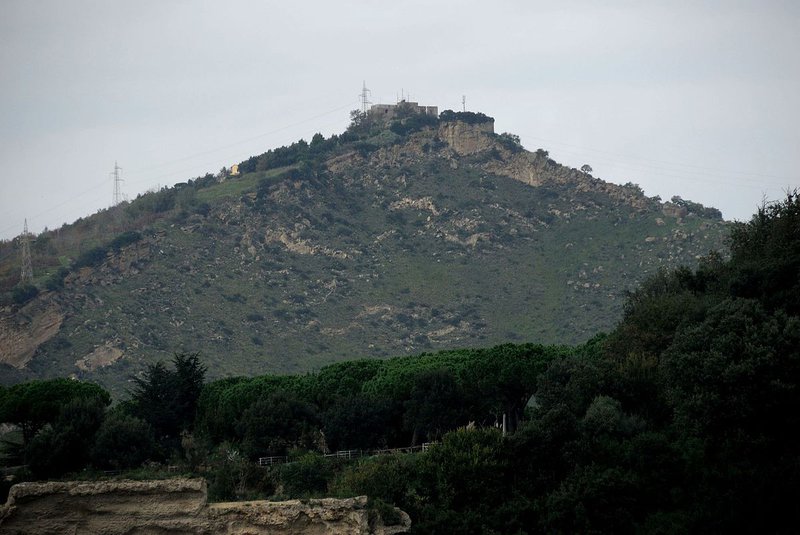
Monte Gauro seen from Lago Averno
https://upload.wikimedia.org/wikipedia/commons/thumb/e/e2/Monte_Gauro-Seen_from_Lago_Averno.JPG/1200px-Monte_Gauro-Seen_from_Lago_Averno.JPG
Bay of Naples Day Trip: Monte Gauro / Monte Barbaro
Monte Nuovo
Monte Nuovo
Monte Nuovo ("New Mountain") is a cinder cone volcano within the Campi Flegrei caldera, near Naples, southern Italy. A series of damaging earthquakes and changes in land elevation preceded its only eruption, during the most recent part of the Holocene, which lasted from September 29 to October 6, 1538, when it was formed. The event is important in the history of science because it was the first eruption in modern times to be described by a large number of witnesses. The eruptive vent formed next to the medieval village of Tripergole on the shores of the then-much larger Lake Lucrino. The thermal bath village, which had been inhabited since ancient Roman times and was home to notable Roman-era buildings including Cicero's villa, was completely buried by ejecta from the new cinder cone. Tripergole's ruins and its important thermal springs completely disappeared under Monte Nuovo such that the exact location of the village can no longer be identified.
Source: Wikipedia https://en.wikipedia.org/wiki/Monte_Nuovo
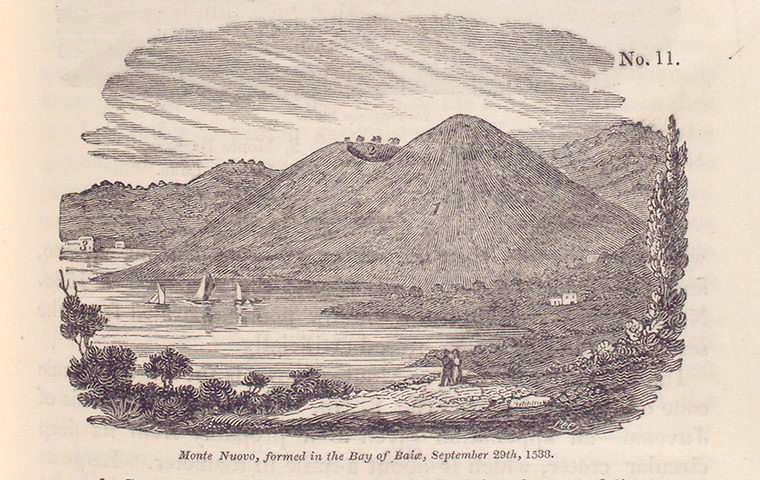
Atlas Obscura: Monte Nuovo 1538 (New York Public Library)
https://www.atlasobscura.com/places/monte-nuovo
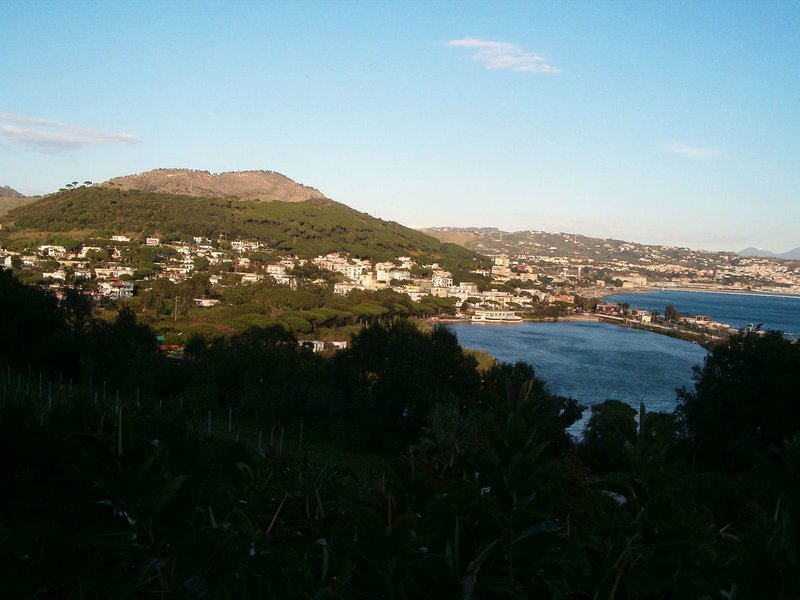
Atlas Obscura: Monte Nuovo and Lago di Lucrino (Wiki User Denghiù)
https://www.atlasobscura.com/places/monte-nuovo
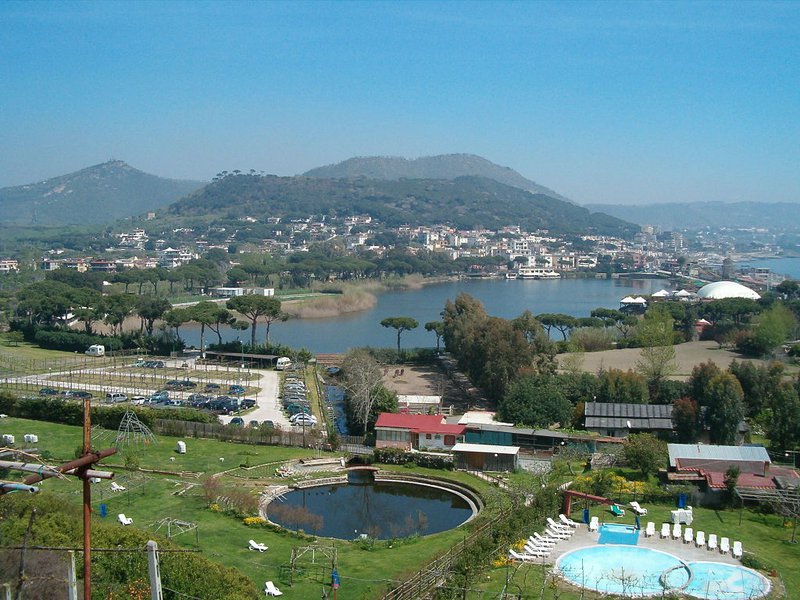
Monte Nuovo and Lago di Lucrino
https://upload.wikimedia.org/wikipedia/it/thumb/8/8c/LucrinoMonteNuovoTAW4509.JPG/1024px-LucrinoMonteNuovoTAW4509.JPG
Bay of Naples Day Trip: Monte Nuovo
Piscina Mirabilis
Piscina Mirabilis
The Piscina Mirabilis (Latin "wondrous pool") is an ancient Roman cistern on the Bacoli hill at the western end of the Gulf of Naples, southern Italy. It was one of the largest ancient cisterns. It was built under Augustus as suggested by the building technique of opus reticulatum used in the walls.
The cistern was dug entirely out of the tuff hill and was 15 metres (49 ft) high, 72 metres (236 ft) long, and 25 metres (82 ft) wide. The capacity was 12,600 cubic metres (440,000 cu ft). It was supported by vaulted ceilings and a total of 48 pillars.
Source: Wikipedia
https://en.wikipedia.org/wiki/Piscina_Mirabilis
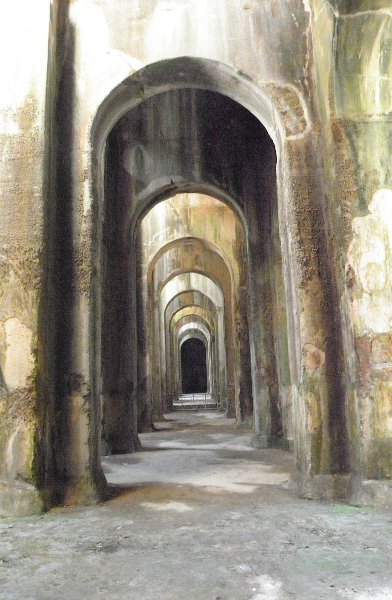
Piscina Mirabilis (Ra Boe)
https://commons.wikimedia.org/w/index.php?curid=11441896
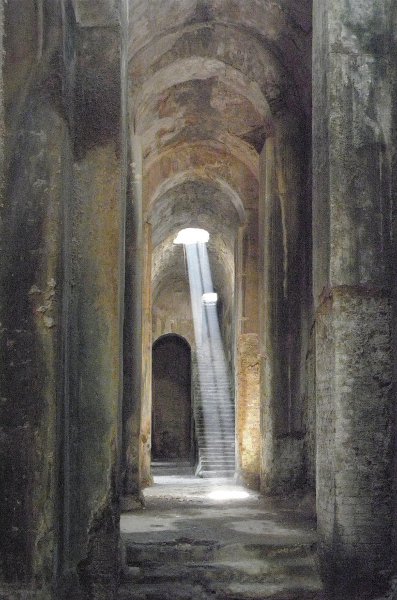
(Ra Boe)
https://commons.wikimedia.org/w/index.php?curid=11441879
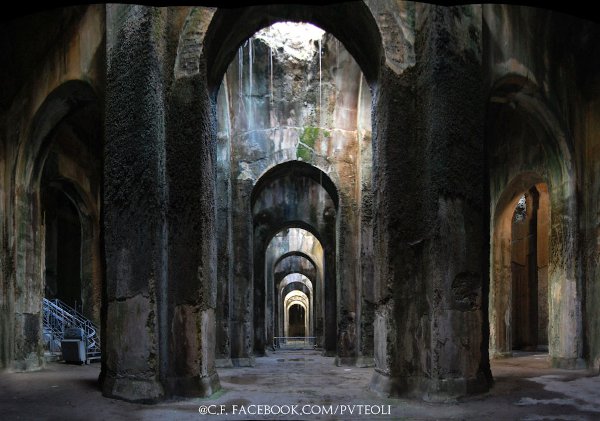
Piscina Mirabilis
http://www.archeoflegrei.it/wp-content/uploads/2016/06/DSC_8417-1024x719.jpg
Bay of Naples Day Trip: Piscina Mirabilis
Posillipo Tunnel / Roman Seiano tunnel
Posillipo Tunnel / Roman Seiano tunnel
Now called Roman Seiano tunnel; previously known as the Crypta Napolitana. In his letter to his wife in June 1770, Leopold Mozart described it as the 'Grotto di Pozzuoli'.
Posillipo is a residential quarter of Naples, located along the northern coast of the Gulf of Naples. From the 1st century BC the Bay of Naples witnessed the rise of villas constructed by elite Romans along the most panoramic points of the coast, who had chosen the area as a favourite vacation spot. The remains of some of these as well as the Seiano tunnel can be seen today in the Parco archeologico del Pausilypon, or Posillipo Archaeological Park...
The extraordinary 770 metre-long tunnel of the "Seiano cave" passes beneath the Posillipo hill and connected the imperial villa and other patrician villas nearby with the Phlegrean Fields (Campi Flegrei) and the towns and ports of Puteoli (Pozzuoli) and Cumae. It owes its name to Lucius Aelius Seianus, prefect of Tiberius, who according to tradition commissioned its enlargement in the first century AD; the first tunnel was built 50 years earlier by architect Lucius Cocceius Auctus at the behest of Agrippa. The eastern entrance is cut into the rock cliff within the archaeological park while the western entrance was a monumental arch with opus reticulatum lining the cliff sides, and both ends being of about 14 m height.
The height, width and length of the tunnel made it a great engineering achievement and an extravagant one considering it served only a small population.
Source: Wikipedia - https://en.wikipedia.org/wiki/Posillipo
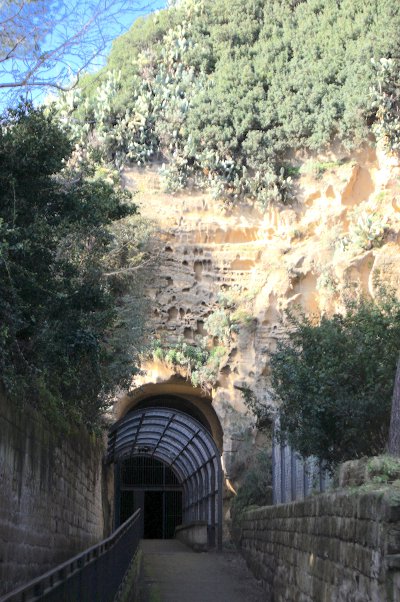
Seiano Tunnel : East entrance
Source: By Rjdeadly - Own work, CC BY-SA 4.0, https://commons.wikimedia.org/w/index.php?curid=74832072
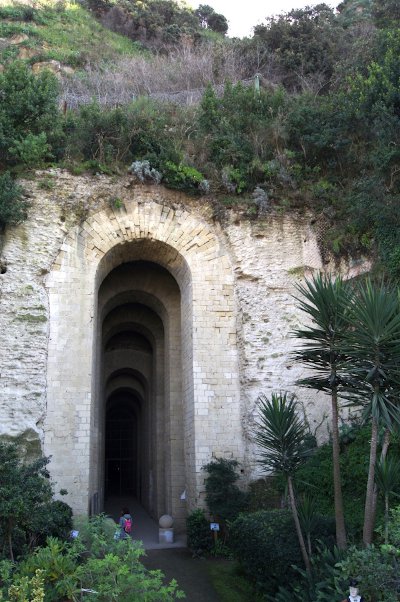
Seiano Tunnel : West entrance
Source: By Rjdeadly - Own work, CC BY-SA 4.0, https://commons.wikimedia.org/w/index.php?curid=74832072
Bay of Naples Day Trip: Posillipo Tunnel (Leopold's 'Grotto di Pozzuoli')
Pozzuoli
Pozzuoli
The city is located on the gulf of Naples in a fascinating, fantastical area known as the Phlegrean Fields (Campi Flegrei, meaning Burning Fields), a geologic wonderland of strange phenomena. Here you'll find collapsed calderas, steaming emissions called fumarole, and the dormant volcano Solfatara. Pozzuoli, along with neighbouring towns in the Phlegrean Fields, is part of a UNESCO World Heritage Site because of the geologic process called "bradyseism" that is found here, a particular geo-seismic phenomenon from the gradual uplift and descent of the Earth's crust caused by the filling and emptying from hydrothermal activity. It draws scientists and curiosity-seekers from around the world to see it for themselves.
Pozzuoli was founded in 529 BC by local Samnite tribes, but didn't become a city until the Romans took over in 338 BC and named it Puteoli. It grew quickly and became an important port and commercial centre for the Roman Empire. The Apostle Paul stopped here on his way to Rome to appeal his sentence before Caesar, as noted in the Acts of the Apostles. The city was so important that it was embellished with two amphitheaters, along with temples, housing blocks, a forum, and a necropolis. It seemed to be the empire's jewel - until the port of Ostia Antica opened, much closer and more accessible to the Capital City. Thus started the decline of Roman Pozzuoli. There are rich archeological sites there to see today.
Source: summerinitaly.com/guide/pozzuoli
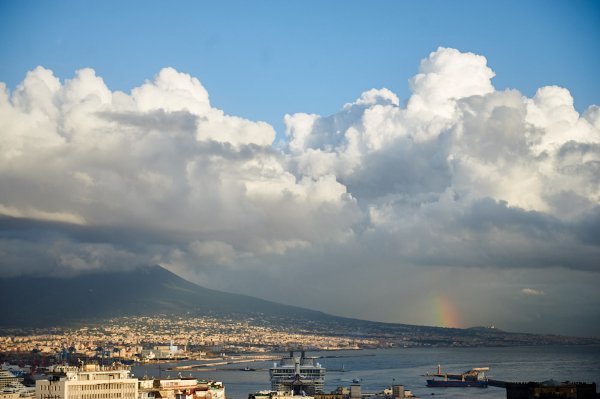
Pozzuoli - Panorama (Ursula Schmitz)
https://photosandthecity.com/pozzuoli-naples-italy/
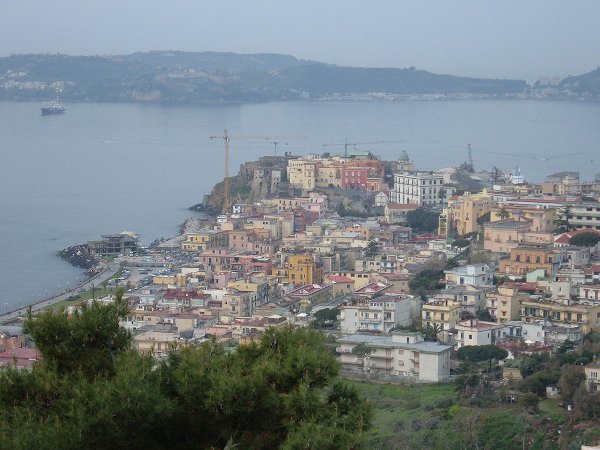
Pozzuoli - view of the city
By Own work, CC BY-SA 3.0, https://commons.wikimedia.org/w/index.php?curid=1144697
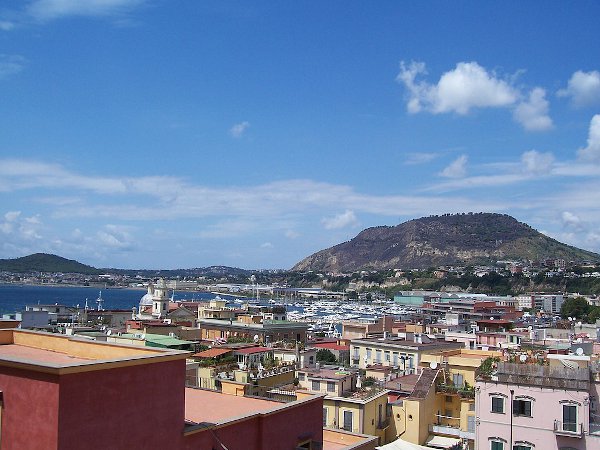
Pozzuoli - view of the city (Ferdinando Marfella)
https://www.britannica.com/place/Pozzuoli
Bay of Naples Day Trip: Pozzuoli
Pozzuoli - Cathedral
Pozzuoli - Cathedral
Pozzuoli Cathedral or the Basilica of San Procolo martire is the main Roman Catholic church in Pozzuoli and the seat of the Diocese of Pozzuoli. It sits at the top of the Rione Terra and is built around an ancient Roman temple.
The site probably originated as part of the town's capitolium of the Greek or Samnite era, radically rebuilt in the Republican and Augustan eras. The church was first housed in a former Roman temple, the Temple of Augustus built by the rich merchant Lucius Calpurnius. Its dedicatory inscription survives, reading L. Calpurnius L.f. templum Aug. cum ornamentis d.s.f. (Lucius Calpurnius, son of Lucius, dedicated this temple and its ornamentation to Augustus at his own expense). It was designed by the architect Cocceius Auctus on the remains of an earlier Republican temple built in 194 BC, which had been restored by Sulla in 78 BC. The Temple of Augustus was a pseudoperipteral exastyle temple, with nine fluted Corinthian columns along each long side and a rectangular cella formed of white marble blocks. The whole temple was built without the use of mortar. Between the end of the 5th and the start of the 6th century the inhabitants of the town decided to rededicate the temple as a church to Proculus of Pozzuoli. In 1538 it suffered major damage as Tripergole subsided and Monte Nuovo was formed. Bishop Gian Matteo Castaldo restored it, funding it by selling off all the episcopal stable-ware of the value of 200 gold ducats or less, for which he was given permission by Pope Paul III on 16 June 1544.
Source: Wikipedia https://en.wikipedia.org/wiki/Pozzuoli_Cathedral
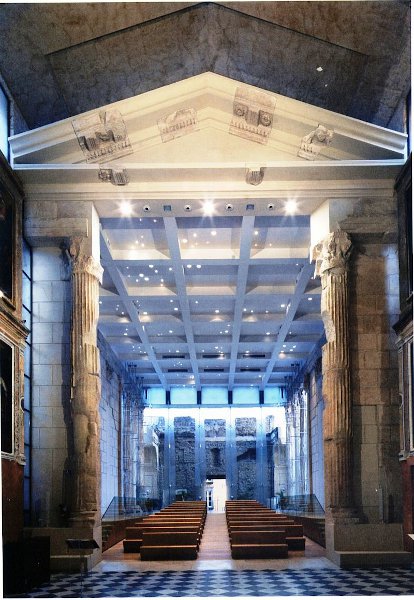
Pozzuoli Cathedral (Basilica of San Procolo Martire)
By FAM1885 - Own work, CC BY-SA 4.0, https://commons.wikimedia.org/w/index.php?curid=55970493
Bay of Naples Day Trip: Pozzuoli - Cathedral
Pozzuoli - Old Harbour
Pozzuoli - Old Harbour
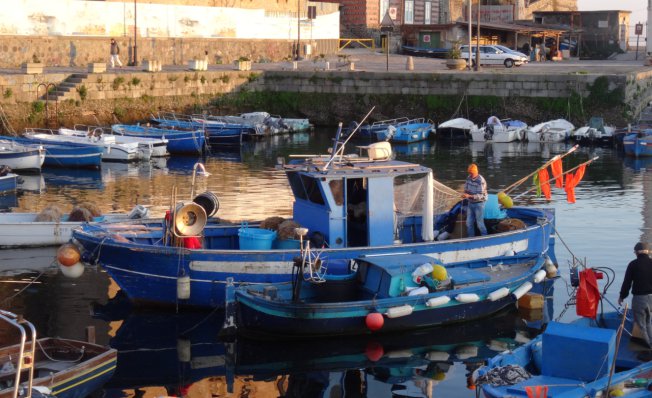
Fishing boat in the old harbour of Pozzuoli
https://thephraser.com/2015/04/08/pozzuoli-harbour-amphitheatre-and-solfatara/
Bay of Naples Day Trip: Pozzuoli Harbour (Il Molo de Pozzuoli)
Solfatara
Solfatara
Solfatara (Italian: Solfatara di Pozzuoli) is a shallow volcanic crater at Pozzuoli, near Naples, part of the Phlegraean Fields (Italian: Campi Flegrei) volcanic area. It is a dormant volcano, which still emits jets of steam with sulfurous fumes. The name comes from the Latin, Sulpha terra, "land of sulfur", or "sulfur earth". It was formed around 4000 years ago and last erupted in 1198 with what was probably a phreatic eruption - an explosive steam-driven eruption caused when groundwater interacts with magma. The crater floor is a popular tourist attraction, as it has many fumaroles and mud pools. The area is well known for its bradyseism. The vapours have been used for medical purposes since Roman times.
Source: Wikipedia https://en.wikipedia.org/wiki/Solfatara_%28volcano%29

Solfatara Crater (Patrick Massot)
By Patrick Massot - Own work, CC BY-SA 4.0, https://commons.wikimedia.org/w/index.php?curid=36590521
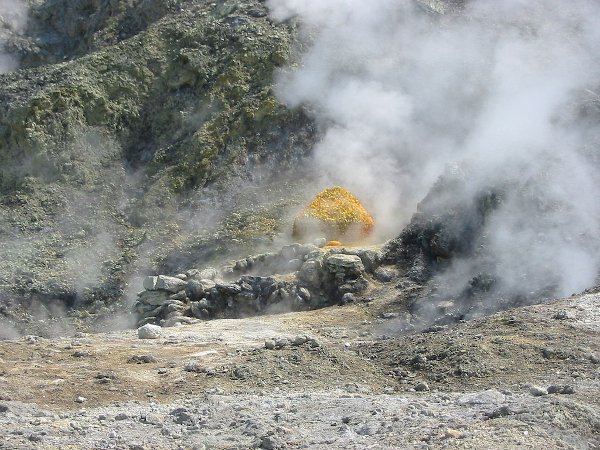
Solfatara - Fumerole (Donar Reiskoffer)
By Donar Reiskoffer, CC BY-SA 3.0, https://commons.wikimedia.org/w/index.php?curid=238345
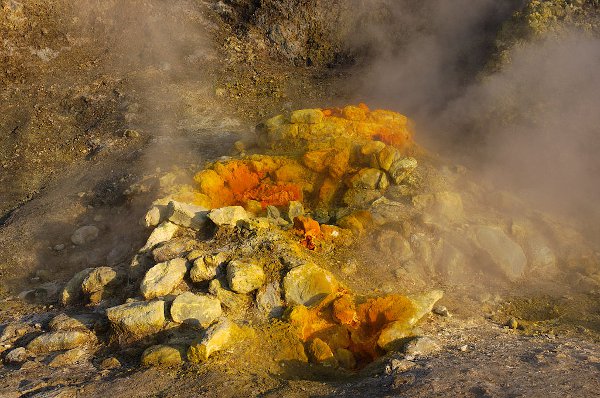
Solfatara - Fumerole (close-up) (Patrick Massot)
By Patrick Massot - Own work, CC BY-SA 4.0, https://commons.wikimedia.org/w/index.php?curid=36590523
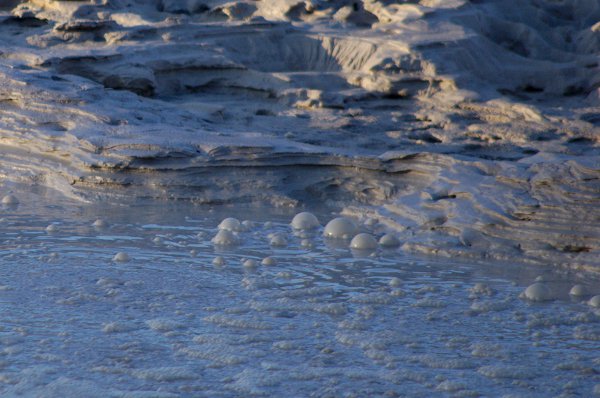
Solfatara - Mud pool (Patrick Massot)
By Patrick Massot - Own work, CC BY-SA 4.0, https://commons.wikimedia.org/w/index.php?curid=36590520
Bay of Naples Day Trip: Solfatara
Temple of Diana
Temple of Diana
This colossal ogival dome, today half collapsed, originally collected vapours coming from the ground below and was used for thermal baths. It was decorated with marble friezes depicting hunting scenes.
Source: https://en.wikipedia.org/wiki/Baiae#Temple_of_Diana
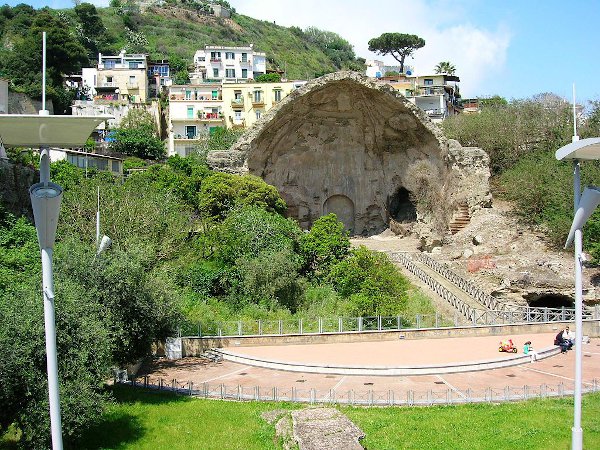
Temple of Diana (Mentnafunangann)
https://commons.wikimedia.org/w/index.php?curid=32519791
Bay of Naples Day Trip: Temple of Diana
Temple of Mercury
Temple of Mercury
The Temple of Mercury consists of an enormous 21.5 m (71 ft) diameter dome, a miracle of engineering and the largest in the world prior to the construction of Rome's Pantheon in ad 128.
It was, and is still today, used to enclose the frigidarium or cold pool of the public baths. From eighteenth century descriptions it appeared to have had six niches of which four were semicircular.
Source: https://en.wikipedia.org/wiki/Baiae#Temple_of_Mercury
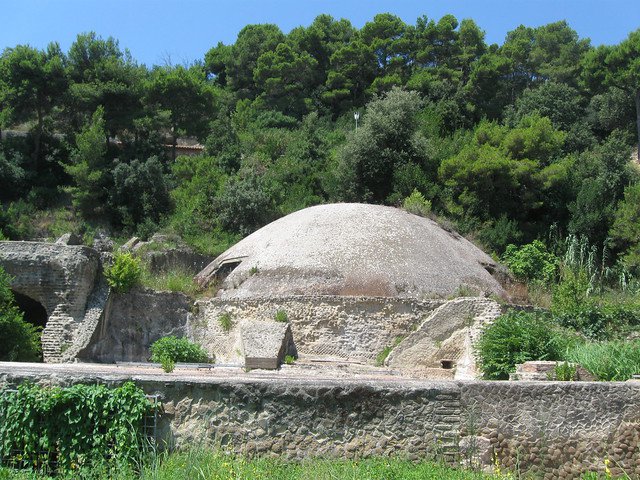
Temple of Mercury
https://farm7.staticflickr.com/6083/6052012490_7ce961f5bf_z.jpg
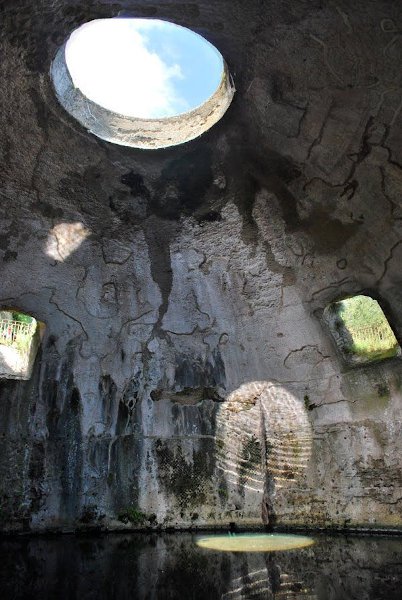
Temple of Mercury
https://i.pinimg.com/originals/ad/99/c6/ad99c656b894c97435c720ff03239ad3.jpg
Bay of Naples Day Trip: Temple of Mercury
Temple of Venus
Temple of Venus
Another octagonal building, sunken 3 metres in the ground, had eight large arched windows and a balcony inside overlooking the pool. It owes its name to Scipione Mazzella who claimed to have found the statue of the goddess there.
Source: https://en.wikipedia.org/wiki/Baiae#Temple_of_Venus
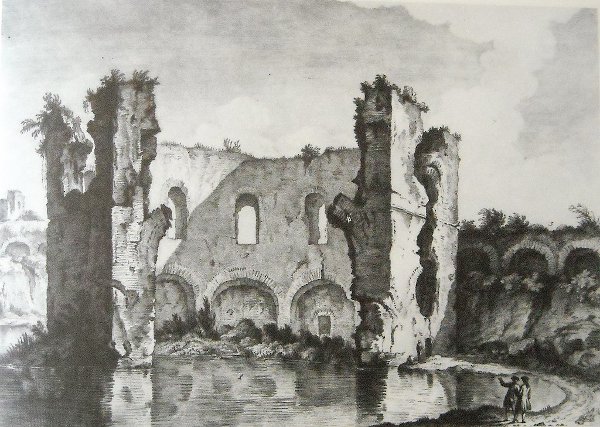
Temple of Venus (Morghen)
https://live.staticflickr.com/2935/13969458703_50b0207e82_b.jpg
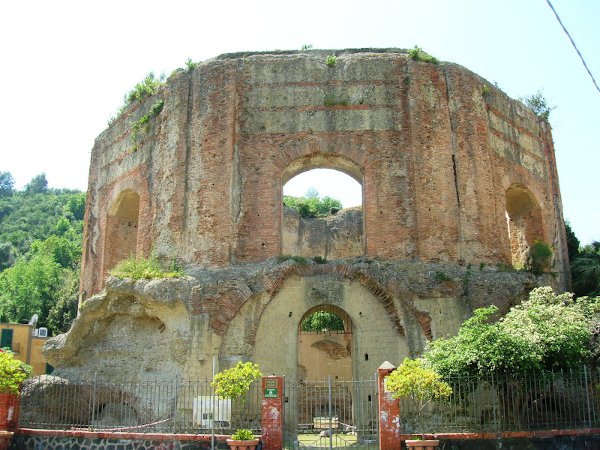
Tempio di Venere-Baia
https://upload.wikimedia.org/wikipedia/commons/1/1f/Tempio_di_Venere_(Baia)_1.JPG
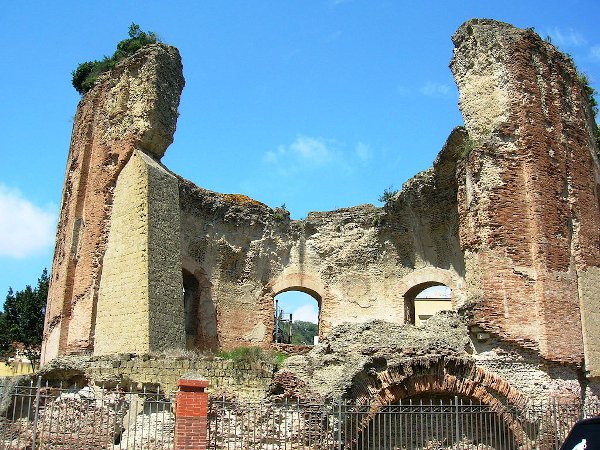
Tempio di Venere (Baia) (Mentnafunangann)
https://commons.wikimedia.org/w/index.php?curid=32518191
Bay of Naples Day Trip: Temple of Venus
Virgil's Tomb
Virgil's Tomb
"A place of immense natural beauty, a quiet spot at the foot of Posillipo hill overlooking Vesuvius and the Bay.
- Here, with perhaps the loveliest view on earth outspread before him, he composed his two great works, the “Georgics” and “AEneid,” whose glory has outlived by many centuries the Roman Empire itself. The word Posillipo means “freedom from sorrow” and, apparently, the poet found the situation worthy of its name; for when he died at Brindisi, just nineteen years before the birth of Christ, he begged the Emperor Augustus, with whom he was then traveling, to see that his remains were brought back and buried on this hill. John L. Stoddard.
For over 2000 years, Virgil’s tomb has been a place of pilgrimage. A tradition that would come and go in fits and starts throughout the ages. In the first century AD it was said that the Roman poet Silius Italicus (c. 28 – 103 AD) owned Virgil’s tomb and dedicated himself to preserving the poet’s memory. It was a scene that the English painter Joseph Wright depicted some sixteen centuries later in his Virgil’s Tomb, with the Figure of Silius Italicus (1779).
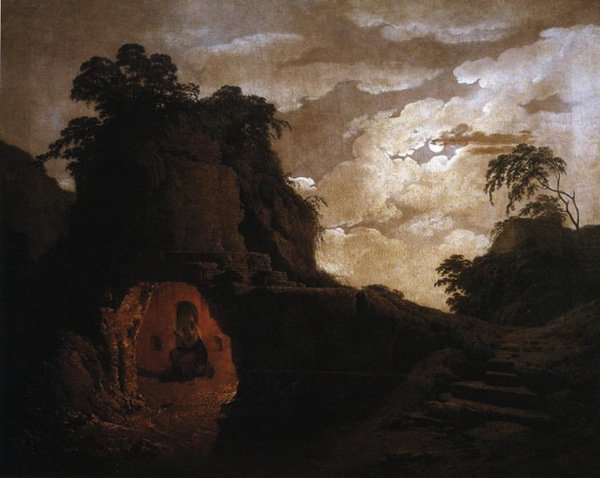
Joseph Wright of Derby. Virgils Tomb with the Figure of Silius Italicus. 1779
Looking at Wright’s painting, it seems to me that his use of the chiaroscuro effect conjures up an air of mysticism. And I can’t help but wonder if Wright, like so many pilgrims before and after him, made the journey to Virgil’s tomb seeking inspiration or something more?
Dante’s guide in Hell in The Divine Comedy, the Middle Ages turned the poet into a sorcerer and seer, ascribing to him all sorts and manners of miracles. The magic egg hidden in Castel dell’Ovo that protects the city from some nefarious fate. The miraculous creation of the Crypta Napolitana, a 700 meter tunnel burrowed through Posillipo hill that was built during the Augustan period to connect Naples to Pozzuoli."
Source: Bonnie Alberts: https://www.napoliunplugged.com/treasures-of-napoli-virgils-tomb.html
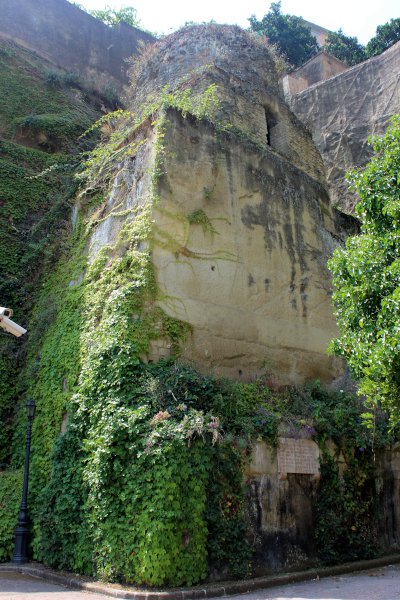
Virgil's Tomb : Miguel Hermoso Cuesta
Source: By Miguel Hermoso Cuesta - Own work, CC BY-SA 4.0, https://commons.wikimedia.org/w/index.php?curid=37949031
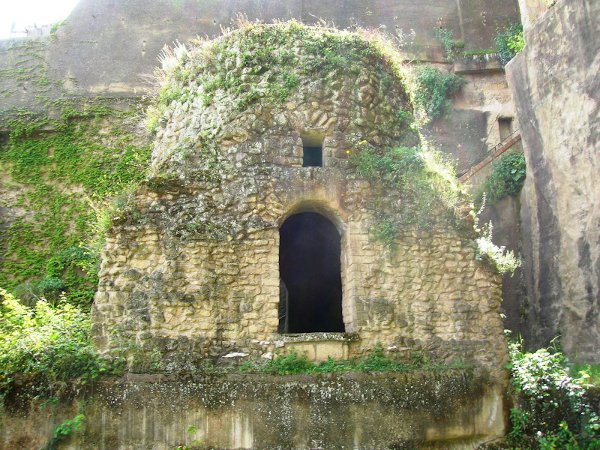
Virgil's Tomb : Mentnafunangann
Source: By Mentnafunangann - Own work, CC BY-SA 3.0, https://commons.wikimedia.org/w/index.php?curid=32354348
Bay of Naples Day Trip: Virgil's Tomb